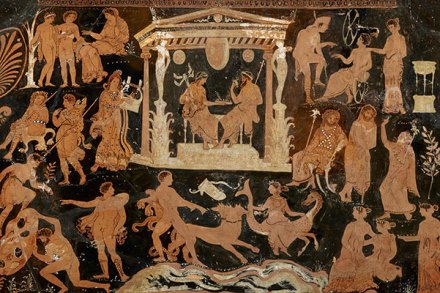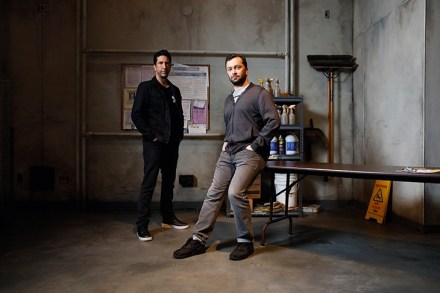Books and Arts – 13 December 2018

The good, bad and ugly in arts and exhbitions
Alexander McCall Smith There is a painting in the Scottish National Gallery of Modern Art that I find quite haunting. It is called ‘A Portrait Group’, and is by the Scottish artist James Cowie. Cowie painted this picture in 1933 and then reworked it in 1940. He was an art teacher, and often used his pupils as models. In this painting, he didn’t get the models to sit together, but created the painting from separate studies he had made of various sitters. For me it is about friendship. Here are four young people on the cusp of their adult lives. What lies ahead of them? Will they find


Take yourself back to (or try to imagine) Christmas 1968; a year full of disturbances, dashed hopes and extreme violence at home and abroad. On 21 December, a huge explosion occurred; not, for once, a herald of catastrophe but at Cape Kennedy, where the engines of the Saturn V rocket, ‘the most powerful machine ever made’, were ignited, launching the Apollo 8 mission. Three astronauts in a tiny metal box were thrown up into space. Three days later, on Christmas Eve, they would broadcast back to the world images that would change for ever the way we see our planet. As they orbited the moon, the first astronauts to do

Jimmy McGovern’s one-off drama Care (BBC1, Sunday 9 December) began with a loving grandmother called Mary having a lovely time with her loving grandchildren. During a laughter-filled visit to the chip shop, she also tested their maths by asking how much their order would cost, and they answered with impressive aplomb. So could it be that McGovern — whose previous work (The Lakes, The Street, Broken etc.) has never been difficult to distinguish from a ray of sunshine — was getting into the festive mood? Well, no. As she drove away from the chippy, Mary slumped forward on to the steering wheel as the children screamed and the car headed

Sam Shepard was perhaps the gloomiest playwright ever to spill his guts into a typewriter. The popularity of his work must owe itself to some deep grudge nursed by America’s elite against the redneck states. True West is a standard Shepard ordeal: a pair of damaged, inadequate, bitter, loveless white males are cudgelling each other to pieces in a dingy Californian hellhole. For good measure he adds a dollop of bad plotting and improbable detail. We meet two thick angry brothers, Austin and Lee, living together in the house of their absent mom. Austin is busy writing a screenplay and Lee wants to borrow Austin’s car to go on a

Not another Nutcracker, I thought on the way to the Opera House. Haven’t we had our fill of Sugar Plums? I took my seat, the Grinch of Covent Garden, wondering if we couldn’t have The Winter’s Tale for a change. The lights went down, the orchestra assembled and within six bars of Tchaikovsky’s irresistibly sparkling score I was sinking into my seat as into a bath of hot Glühwein and contentedly sighing: bring on the dancing snowflakes… Peter Wright’s production, with sets and costumes by Julia Trevelyan Oman, remains a midwinter night’s dream of Lebkuchen cosiness: snow-capped gables, Biedermeier comfort, goffered mob caps and Fezziwig frock coats, as pretty as

So, Mary Poppins returns, and I was, of course, primed to be spiteful, as is my nature. Not a patch on the original. Why did they bother? Why did they imagine it was necessary? Wasn’t the first film practically perfect in every way? Have someone play her who isn’t Julie Andrews? Are you right in the head? The original (1964) is one of the best-loved films ever. I love it, even though the fact that Mrs Banks was made to put away her suffragette nonsense to become a Proper Mother now makes me go: grrrr. So I had my spite at the ready. My spite was champing at the bit.
As the old year dies, our thoughts turn to what happens next. What better time, then, to cast a seasonally morbid, deeply philosophical, and curiously uplifting pod with David Saunders of the J. Paul Getty Museum in California? The Getty Villa’s new exhibition, Underworld: Imagining the Afterlife is all about ideas of what happened next if you died as an Ancient Greek. The Greeks thought of the Underworld, or ‘House of Hades’, as a bleak and somber location, defined by the absence of life’s pleasures. Not surprisingly, this Hotel California of the soul was a rare subject in Greek art. And, not surprisingly, the prospect of a one-way ticket on

There is very little art about modern poverty, because who wants to know? It is barely acknowledged, unless there is redemption, or salvation, as in A Christmas Carol. Those most suited to make it — those who are actually poor — are usually too busy doing something else, such as surviving. So, it is remarkable to learn that Alexander Zeldin’s play LOVE, a success at the National Theatre in 2016, is now a film and will air this weekend on BBC2. The closest thing to it recently was Benefits Street, which was exploitative and, therefore, an instant hit. Zeldin is 33. He read French at Oxford University and is artist-in-residence

The Spectator is responsible for many coinages. One of the most significant came in 1968, when an article by our 24-year-old music critic, Michael Nyman, appeared with the headline ‘Minimal Music’ (reprinted below). It was a wry joke about music that was more experimental than strictly minimal but it stuck and a musical style that, whatever you think of it, has rarely been matched in influence or reach was born. Walking home from the Fugs’ concert, organised by the Middle Earth at the Round House last week, I was shocked by the 4 a.m. silence — by its awesome superiority to a lot of modern music, and by its unfamiliarity.


Not a bad year for the award. Honourable mentions must go to the landfill abstractions of Oxford’s new Westgate Centre, to the bees that have appeared in Manchester’s streets to promote the ‘unique buzz’ of the city and to Gillian Wearing, a once decent conceptual artist who has taken to sculpture like a cat to water with her statue of Millicent Fawcett. Nothing, however, brought more mush to our towns than the first world war commemorations. As Simon Jenkins wrote in these pages, ‘reaching for a grand sweeping gesture, something “profound”, is too tempting’ in commissions about war. ‘The search for wishy-washy universals soaks up all the energy and bromides

‘Without death,’ says Salena Godden, ‘life would be a never-ending conveyor belt of sensation.’ For her death is what gives meaning to life and to be able to imagine your own death should make you try harder to be a better person. Mrs Death Misses Death on Radio 4 (produced by Cecile Wright) is not a programme for the faint-hearted. Godden, a poet, novelist and musician, faces with robust clarity what many of us would prefer to distract ourselves from thinking about. She argues that Death is much more likely to be a woman; not the usual caricature of a hooded male figure carrying a sickle. She’s that invisible woman


Don’t watch The Sinner (originally on Netflix; now on BBC4) because, despite your better judgment, you’ll only get addicted after its irresistibly grabby opening. A pretty if slightly distraite mother called Cora Tannetti — Jessica Biel — is on a lakeside beach with her bearded beta cuck husband and their little boy, surrounded by other relaxed groups of weekend picnickers. Suddenly, she takes huge exception to a hunky male sitting nearby and derangedly stabs him to death with a fruit knife. Why? That’s why it’s being sold as a new genre — the ‘whydunit’ — because obviously we know whodunit already. With seven more episodes to go, it’s probably safe

Roma is the latest film from Alfonso Cuaron (Gravity,Y Tu Mama Tambien, Harry Potter and the Prisoner of Azkaban) and you’ll probably already have heard that it’s wonderful, a masterpiece, magnificent, Oscar-worthy. But as I know you won’t believe it until you hear it from me (sigh, the responsibility is too much sometimes) I can confirm all of the above. At this point I should note that many cinephiles have complained that it deserves to be seen at the cinema, on a full-sized screen with full-sized sound, but as it’s a Netflix film (sneer, sneer) most won’t be able to watch it this way. I did see it at the

It’s December, and while musical theatre is busy celebrating ‘warm woollen mittens’, opera, as usual, is far more interested in the tiny frozen hands inside them. Because nothing says Christmas quite like consumption, and I’m not talking turkey and mince pies. London’s opera companies are serving up a heaped sleighful of heartbreak this year. English National Opera is going traditional with La bohème, while the Royal Opera is thinking outside the snow-covered coffin with Carmen. There’s something for everybody, so long as it’s tragedy. ENO’s Bohème is the safe option, the show you take your granny to. She’ll be enchanted by Jonathan Miller’s production, which makes its young bohemians’ poverty

One of the biggest stars of the 1970s was the professional lard-bucket Mick McManus, who plied his trade as an all-in wrestler. The sport was televised to millions. The parents of the playwright Michael McManus must have calculated that by giving their child the same name as ‘The Dulwich Destroyer’ they would subtly galvanise his intellectual ambitions. Their ploy paid off. The young Michael McManus, lumbered with the identity of a potato-shaped pugilist, seems to have toiled night and day to distinguish himself from his pot-bellied namesake. He succeeded in establishing his intellectual credentials by working as a political diarist, a ministerial adviser, and by writing well-received biographies of Jo
This week on the Green Room, I’m talking the blues with Grammy-winning blues artist Chris Thomas King. Earlier this week, King wrote for Spectator USA a scathing criticismof the policies of the Grammys’ Blues category. King is an African American from Louisiana. He is the son of a blues musician, and grew up in his father’s juke joint. He was one of the last blues musicians to be ‘discovered’ by anthropologists from the North. He has won two Grammy awards, in 2001 for the soundtrack of the Coen Brothers’ film O Brother, Where Art Thou?, in which he starred as a blues singer who has sold his soul to the

On 10 September 1973 the 1930s Kensington High Street department store formerly known as Derry & Toms reopened as Big Biba. It sold the dress designer Barbara Hulanicki’s distinctive look in furniture, paints and wallpaper, sports equipment and food, as well as her familiar fast fashion. If you had to define that aesthetic then, you’d have said it was campy and kitschy. But above all you’d have said it was deco, an increasingly familiar word for the between-wars moderne style in everything from buildings to jewellery. Derry & Toms itself was a 1933 moderne temple of commerce, slathered in stylised ironwork and bas-reliefs. It had a ‘Rainbow Room’ upstairs, which


The Assyrians placed sculptures of winged human-headed bulls (lamassus) at the entrances to their capital at Nineveh, in modern Mosul, to ward off evil. The mighty lamassu to the right of the Nergal Gate had been on guard for some 2,700 years when Isis vandals took a drill to it in 2015 and blew away its face. Today a copy, crafted out of date syrup cans, stands on the Fourth Plinth in Trafalgar Square. It wears the oblong beard and proud look of the Assyrian kings. The original sculpture dated to the time of Sennacherib, who ruled Assyria from 705 to 681 BC, and transformed Nineveh into a magnificent metropolis.